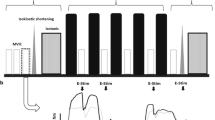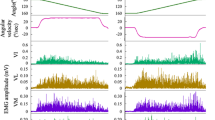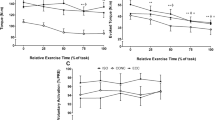Summary
The primary purpose of this investigation was to study the eccentric and concentric torque-velocity characteristics of the quadriceps femoris in man using a recently developed combined isometric, concentric and eccentric controlled velocity dynamometer (the SPARK System). A secondary purpose was to compare the method error associated with maximal voluntary concentric and eccentric torque output over a range of testing velocities. 21 males (21–32 years) performed on two separate days maximal voluntary isometric, concentric and eccentric contractions of the quadriceps femoris at 4 isokinetic lever arm velocities of 0° · s−1 (isometric), 30° · s−1 120° · s−1 and 270° · s−1. Eccentric peak torque and angle-specific torques (measured every 10° from 30° to 70°) did not significantly change from 0° · s−1 to 270° · s−1 (p>0.05) (with the exception of angle-specific 40° torque, which significantly increased;p<0.05). The mean method error was significantly higher for the eccentric tests (10.6%±1.6%) than for the concentric tests (8.1%±1.7%) (p<0.05). The mean method error decreased slightly with increasing concentric velocity (p>0.05), and increased slightly with increasing eccentric velocity (p>0.05). A tension restricting neural mechanism, if active during maximal eccentric contractions, could possibly account for the large difference seen between the present eccentric torque-velocity results and the classic results obtained from isolated animal muscle.
Similar content being viewed by others
References
Asmussen E, Hansen O, Lammert O (1965) The relation between isometric and dynamic muscle strength in man. Comm Danish Natl Assn Infantile Paralysis 21:3–12
Åstrand PO, Rodahl K (1986) Textbook of work physiology, 3rd ed. McGraw-Hill Inc, New York, pp 43–45
Caiozzo VJ, Perrine JJ, Edgerton VR (1981) Training-induced alterations of the in vivo force-velocity relationship of human muscle. J Appl Phyiol: Respir Environ Exerc Physiol 51:750–754
Eloranta V, Komi PV (1980) Function of the quadriceps femoris muscle under maximal concentric and eccentric contractions. Electromyogr Clin Neurophysiol 20:159–174
Gransberg L, Knutsson E (1983) Determination of dynamic muscle strength in man with acceleration controlled isokinetic movements. Acta Physiol Scand 119:317–320
Hanten W, Ramberg C (1988) Effect of stabilization on maximal isokinetic torque of the quadriceps femoris muscle during concentric and eccentric contractions. Physiol Ther 68:219–222
Ingemann-Hansen T, Halkjaer-Kristensen J (1979) Force-velocity relationships in the human quadriceps muscles. Scand J Rehabil Med 11:85–89
Jacobs I, Pope J (1986) A computerized system for muscle strength evaluation: measurement reproducibility, validity and some normative data. NSCA J 8(3):28–33
Jørgensen K (1976) Force-velocity relationship in human elbow flexors and extensors. Biomechanics V pp 145–151
Komi PV (1973) Measurement of the force-velocity relationship in human muscle under concentric and eccentric contractions. Med Sport 8:224–229
Levin A, Wyman J (1927) The viscous elastic properties of muscle. Proc R Soc Biol [Lond] 101:218–243
Osternig LR (1986) Isokinetic dynamometry: implications for muscle testing and rehabilitation. Exerc Sport Sci Rev 14:45–80
Perrine JJ, Edgerton VR (1978) Muscle force-velocity and power-velocity relationship under isokinetic loading. Med Sci Sports Exerc 10(3):159–166
Petrofsky JS, Phillips CA (1986) The physiology of static exercise. Exerc Sport Sci Rev 14:45–80
Rodgers KL, Berger RA (1974) Motor-unit involvement and tension during maximum, voluntary concentric, eccentric, and isometric contractions of the elbow flexors. Med Sci Sports Exerc 6(4):253–259
Sapega AA, Nicholas JA, Sokolow D, Saraniti A (1982) The Nature of torgue “overshoot” in cybex isokinetic dynamometry. Med Sci Sports Exerc 14:368–375
Seger JY, Westing SH, Hanson M, Karlson E, Ekblom B (1988) A new dynamometer for measuring concentric and eccentric muscle strength during accelerated, decelerated or isokinetic movements: validity and reproducibility. Eur J Appl Physiol 57:526–530
Smidt GL (1973) Biomechanical analysis of knee flexion and extension. J Biomechanics 6:79–92
Thorstensson A (1976) Muscle strength, fibres types and enzyme activities in man. Acta Physiol Scand Suppl 433
Winter DA, Wells RP, Orr GW (1981) Errors in the use of isokinetic dynamometers. Eur J Appl Physiol 46:397–408
Wickiewicz TL, Roy RR, Powell PL, Perrine JJ, Edgerton VR (1984) Muscle architecture and force-velocity relationships in humans. J Appl Physiol Respirat Environ Exerc Physiol 57:435–443
Author information
Authors and Affiliations
Rights and permissions
About this article
Cite this article
Westing, S.H., Seger, J.Y., Karlson, E. et al. Eccentric and concentric torque-velocity characteristics of the quadriceps femoris in man. Europ. J. Appl. Physiol. 58, 100–104 (1988). https://doi.org/10.1007/BF00636611
Accepted:
Issue Date:
DOI: https://doi.org/10.1007/BF00636611




